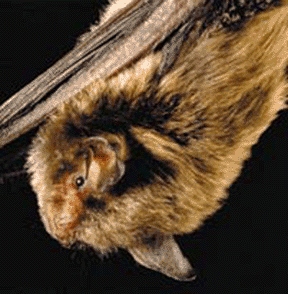It is hard to guess what a Indiana bat weights. But we have the answer:
An adult Indiana bat (Myotis sodalis) on average weights 7 grams (0.02 lbs).
The Indiana bat is from the family Vespertilionidae (genus: Myotis). It is usually born with about 4 grams (0.01 lbs). They can live for up to 20 years. When reaching adult age, they grow up to 4.7 cm (0′ 2″). On average, Indiana bats can have babies 1 times per year with a litter size of 1.
As a reference: An average human weights in at 62 kg (137 lbs) and reaches an average size of 1.65m (5′ 5″). Humans spend 280 days (40 weeks) in the womb of their mother and reach around 75 years of age.

The Indiana bat (Myotis sodalis) is a medium-sized mouse-eared bat native to North America. It lives primarily in Southern and Midwestern U.S. states and is listed as an endangered species. The Indiana bat is gray, black, or chestnut in color and is 1.2–2.0 in long and weighs 4.5–9.5 g (0.16–0.34 oz). It is similar in appearance to the more common little brown bat, but is distinguished by its feet size, toe hair length, pink lips, and a keel on the calcar.Indiana bats live in hardwood and hardwood-pine forests. It is common in old-growth forest and in agricultural land, mainly in forest, crop fields, and grasslands. As an insectivore, the bat eats both terrestrial and aquatic flying insects, such as moths, beetles, mosquitoes, and midges.The Indiana bat is listed as an endangered species by the U.S. Fish and Wildlife Service. It has had serious population decline, estimated to be more than 50% over the past 10 years, based on direct observation and a decline on its extent of occurrence.
Animals of the same family as a Indiana bat
We found other animals of the Vespertilionidae family:
- Brown pipistrelle with a weight of 6 grams
- Large forest bat with a weight of 6 grams
- New Guinea long-eared bat with a weight of 7 grams
- Large-footed bat with a weight of 10 grams
- Keen’s myotis with a weight of 6 grams
- Rüppell’s broad-nosed bat with a weight of 26 grams
- Scully’s tube-nosed bat with a weight of 5 grams
- Intermediate long-fingered bat with a weight of 11 grams
- Moloney’s mimic bat with a weight of 8 grams
- Long-fingered bat with a weight of 8 grams
Animals with the same weight as a Indiana bat
As a comparison, here are some other animals that weight as much as the Myotis sodalis:
- Lesser woolly bat bringing 6 grams to the scale
- Canarian shrew bringing 7 grams to the scale
- Nathusius’s pipistrelle bringing 7 grams to the scale
- Sclater’s shrew bringing 7 grams to the scale
- Arctic shrew bringing 8 grams to the scale
- Southeast Asian long-fingered bat bringing 6 grams to the scale
- Sind bat bringing 7 grams to the scale
- Little bent-wing bat bringing 7 grams to the scale
- Thomas’s horseshoe bat bringing 8 grams to the scale
- Micronycteris nicefori bringing 8 grams to the scale
Animals with the same size as a Indiana bat
Not that size really matters, but it makes things comparable. So here are a couple of animals that are as big as Indiana bat:
- Inyo shrew with a size of 5.2 cm (0′ 3″)
- Pygmy shrew tenrec with a size of 5.6 cm (0′ 3″)
- Common pipistrelle with a size of 3.9 cm (0′ 2″)
- Pacific sheath-tailed bat with a size of 4.7 cm (0′ 2″)
- Thomas’s sac-winged bat with a size of 4 cm (0′ 2″)
- Pygmy fruit-eating bat with a size of 5.5 cm (0′ 3″)
- Lesser horseshoe bat with a size of 3.8 cm (0′ 2″)
- Mexican free-tailed bat with a size of 4.1 cm (0′ 2″)
- Wagner’s mustached bat with a size of 4.5 cm (0′ 2″)
- Kuhl’s pipistrelle with a size of 4.5 cm (0′ 2″)
Animals with the same litter size as a Indiana bat
Here is a list of animals that have the same number of babies per litter (1) as a Indiana bat:
- Bougainville monkey-faced bat
- Ground cuscus
- Noack’s roundleaf bat
- Matschie’s tree-kangaroo
- Large slit-faced bat
- Spotted bat
- Davis’s round-eared bat
- Fox’s shrew
- Broad-toothed mouse
- Eisentraut’s shrew
Animals with the same life expectancy as a Indiana bat
Completely different animals, but becoming as old as a Indiana bat:
- Wolverine with an average maximal age of 18 years
- Mediterranean monk seal with an average maximal age of 23.67 years
- Desert warthog with an average maximal age of 18.75 years
- Egyptian mongoose with an average maximal age of 20 years
- Townsend’s big-eared bat with an average maximal age of 21.17 years
- Matschie’s tree-kangaroo with an average maximal age of 23.83 years
- Silvery marmoset with an average maximal age of 16.75 years
- Lesser kudu with an average maximal age of 18.92 years
- Red giant flying squirrel with an average maximal age of 16 years
- Nyala with an average maximal age of 16 years
